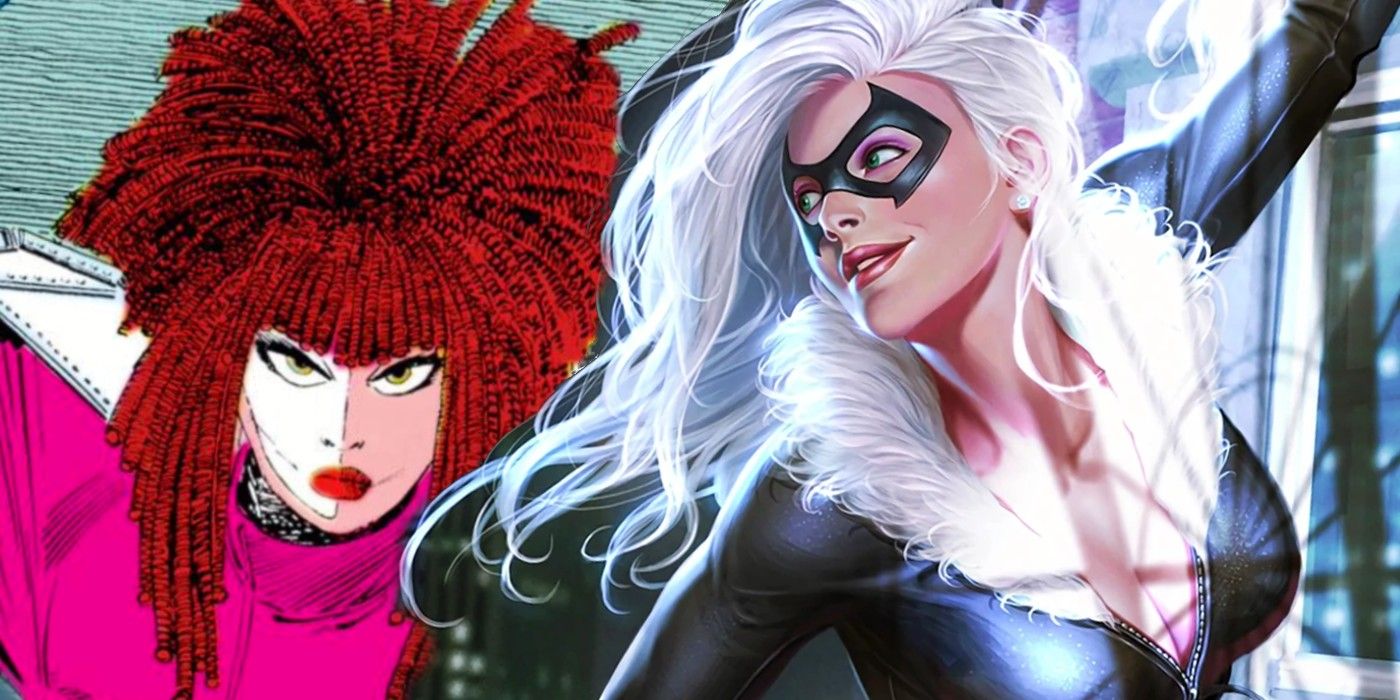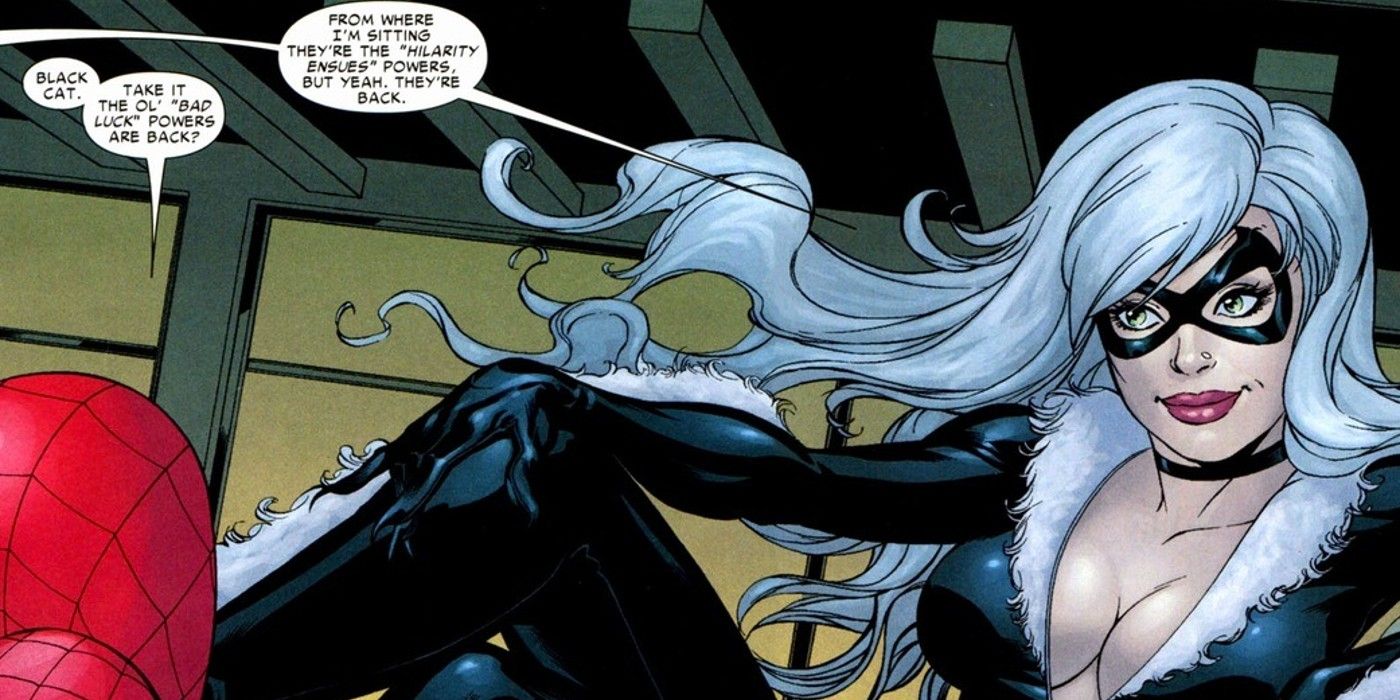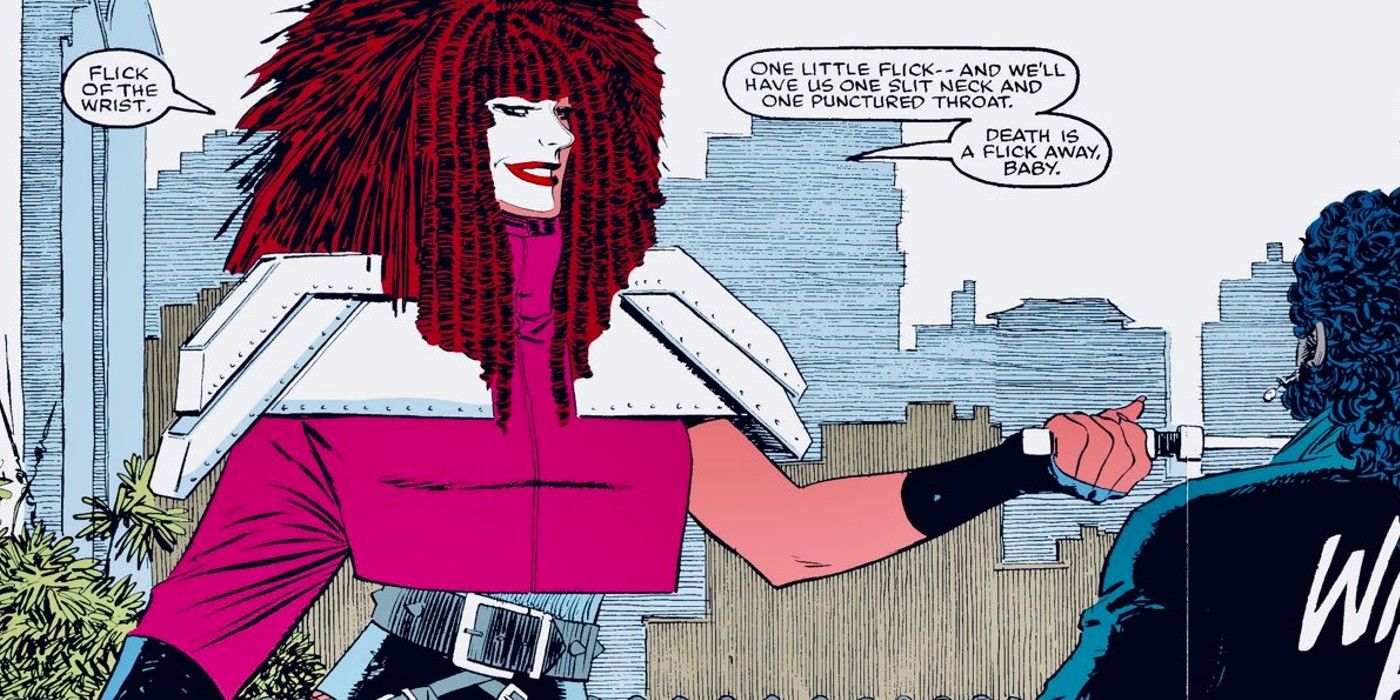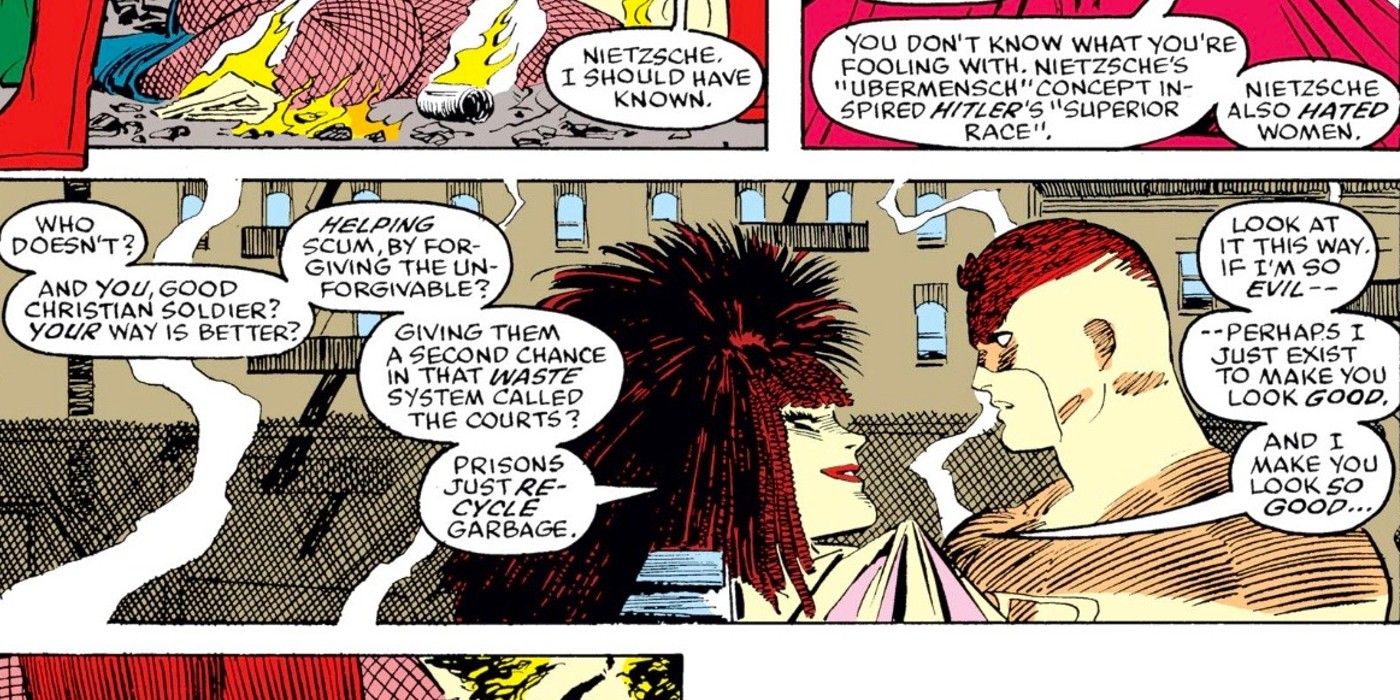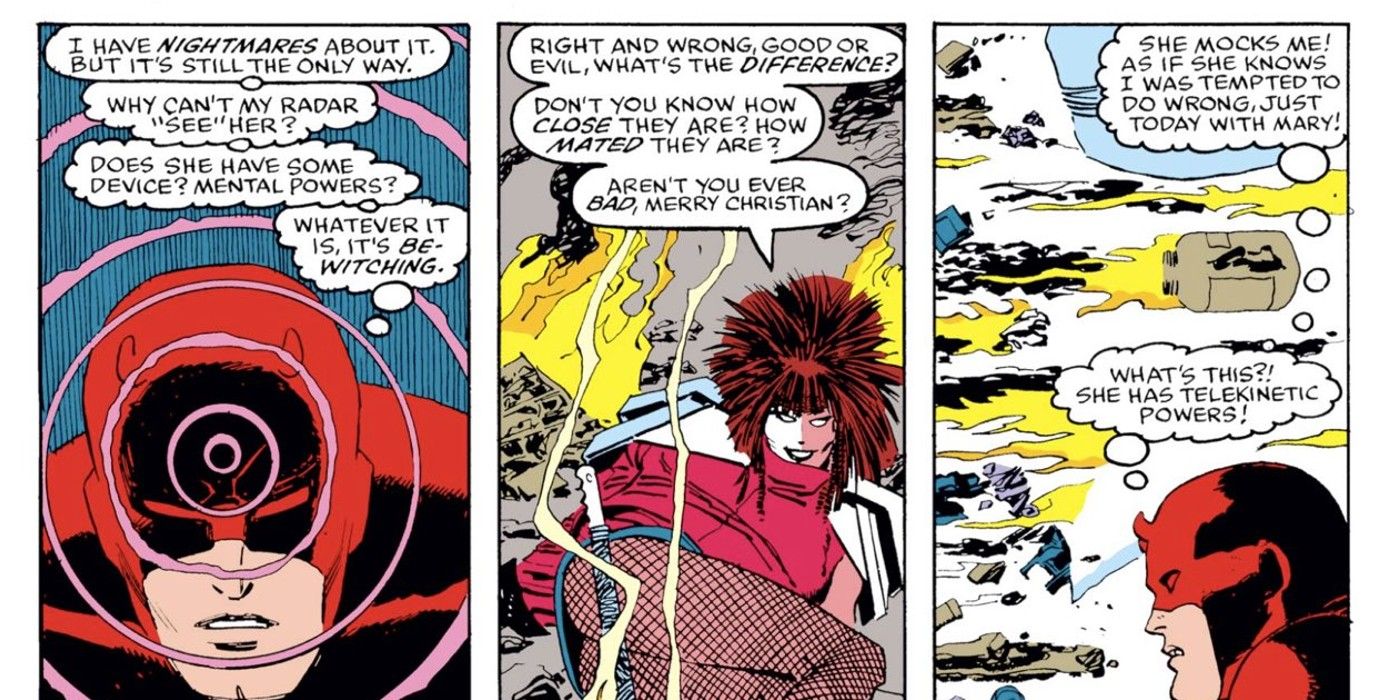The Marvel Comics debut of the Daredevil villain Typhoid Mary dramatically called into question the ways that female villains like Black Cat from Spider-Man had been deemed "villains" in the first place. Contrasting the female villains of her day, Typhoid Mary literally weaponized her own sex appeal by wielding swords and wearing a costume with razor blade-like shoulder pads. Sent on a mission by Kingpin to seduce and eventually destroy Daredevil, Typhoid Mary's introduction in the Marvel Universe shattered the fantasy of the male-gaze that dominated the characterizations of female villains for decades. In doing so Typhoid Mary remains not only one of Marvel's best villains, but also one of its most important in deconstructing the problematic dynamic at the heart of Spider-Man's love life.
Black Cat, also known as Felicia Hardy, was created in 1979 by Marv Wolfman, Keith Pollard, and Dave Cockrum, while Typhoid Mary (Mary Walker) was created in 1988 by Ann Nocenti and John Romita Jr. As her name suggests, Black Cat is a burglar, who enjoys the thrill of risky heists, contrasting the relative safety that Mary Jane Watson poses as a partner for Peter Parker. Typhoid Mary is a mutant with powers including telekinesis, mind control, and pyrokinesis. Mary has dissociative identity disorder, and her Mary Walker persona is gentle in contrast to her Typhoid alter, which violently seeks vengeance and often manipulates men for her own gain and enjoyment. This change between Mary's two personalities are marked by stark differences in her physical appearance, with Typhoid having curly hair and dramatic face paint.
While it would seem to many fans that Peter Parker's true love is Mary Jane (or Gwen Stacy for that matter), his attraction to Black Cat as a "bad girl" is symptomatic of a troubling problem in superhero comics, related to how women are represented from a moral standpoint. For Spider-Man, Black Cat represents a tantalizing reprieve from his moral code without challenging the views that motivate his attraction to her in the first place. Her reputation as the "bad girl" in Spider-Man's life often plays out like a fantasy instead of a concerted effort to discuss the conditions in which women are considered "good," and when they are considered "evil." Typhoid Mary, on the other hand, directly challenged Daredevil's attitudes towards women from her debut, making her a nuanced, deconstructionist response to the femme fatale trope surrounding Black Cat.
While Typhoid Mary is introduced with the basic premise of the femme fatale trope, she possesses an awareness of the trope itself that she uses to not only call Daredevil out on his moral hypocrisy, but the reader's as well. Femme fatales have long been popular in media, thanks to their sex appeal and the long-running problem of the male gaze–so much so that their existence isn't seen as objectionable. Typhoid Mary, however, broke away from this tradition by directly speaking about Daredevil's views towards women, forcing him to consider what was motivating his attraction to her in the first place. In doing so, Typhoid Mary revealed the ugliness behind the femme fatale trope, where characters like Black Cat are hyper-sexualized so that the male protagonist can briefly flirt with "danger" and "evil," forfeiting their humanity to uphold a problematic fantasy.
Typhoid Mary Embodies A New Type of Marvel Villain.
Black Cat's revealing costume and crime sprees threaten the wholesomeness of Spider-Man's character, which is undoubtedly part of her appeal in the first place. And while Black Cat's costume and heists do not automatically make her a "bad" character, she never ascends to an awareness of the trope itself. In other words, Black Cat embodies the "bad girl" fantasy while still remaining amenable to the male gaze, never directly threatening the impulse for women such as herself to be objectified.
On the other hand, Typhoid Mary isn't interested in fulfilling a fantasy for the male gaze, she's interested in deconstructing the moral expectations placed on women in society. Her costume and weaponry represents this exact transgression, with razor-blade shoulder pads, fishnet stockings, and swords embodying an exaggerated form of lethal sexuality that refuses to be passively admired. By dressing herself this way, Typhoid ensures that her body is something to be feared, instead of depersonalized. Typhoid Mary isn't an object, she is a walking transgression of how women are expected to behave in superhero comics, directly challenging Daredevil on his own moral authority. For Daredevil, Typhoid Mary isn't a fantasy or a moral panic: she's an existential crisis.
Typhoid Mary Is Aware Of The Femme Fatale Trope.
Typhoid Mary challenges the "bad girl" trope in superhero comics because she is distinctly aware of the trope itself, using the sexism behind it as a way of achieving her goals. In fact, beginning with her first appearance in Daredevil #254 by Ann Nocenti and John Romita Jr., Typhoid incisively remarks on Daredevil's attitudes towards women and his own morality as she seduces him. And while this could easily fall into the femme fatale territory of Black Cat, Typhoid Mary presents a more complicated version of familiar themes, as her entire persona is built on how women have been pathologized throughout history. Indeed, "Typhoid Mary" was a name given to Mary Mallon, an Irish immigrant who unknowingly infected dozens of people with typhoid fever in New York City during the early twentieth century. Daredevil admits that his attraction to her makes him feel sick, directly externalizing this process.
As Typhoid and Daredevil fight, she quotes Nietzsche, incurring Daredevil's disgust as he mentions that the philosopher "hated women." Not fazed, Typhoid says, "Who doesn't? And you, good Christian soldier? Your way is better? ...Look at it this way. If I'm so evil–perhaps I just exist to make you look good. And I make you look so good..." Here, Typhoid mocks the Catholic moral framework that Daredevil desperately clings to, even though his actions as both Daredevil and Matt Murdock routinely go against the church's teachings. While never explicitly stating that she is "evil," Typhoid saying that "perhaps I just exist to make you look good" reveals how the femme fatale trope has become so morally entangled within the superhero genre.
A key difference between Typhoid Mary and Black Cat is that Typhoid is built upon an exploration into the limits of social acceptability. This idea fits right at home in a Daredevil comic because of the nature of his work as a disabled man perpetually seeking justice through two contradictory avenues. In contrast, Black Cat's character has never been intended to be illuminating within the world of Spider-Man, instead retreading familiar territory of the femme fatale. While Typhoid Mary deliberately hunts down men who have hurt women, Black Cat is a rich woman who enjoys being a burglar, lacking a desire to redistribute what she takes. Between both characters, it's clear that Typhoid Mary's goals and motivations are transformative for society, while Black Cat's are not.
Ultimately, Ann Nocenti and John Romita Jr.'s Daredevil run critiqued the Man Without Fear just as much as it celebrated his best attributes. Typhoid Mary was instrumental in both humanizing Daredevil and fleshing out the complexities of the world he was working in. While the same cannot be said for Spider-Man and Black Cat, that is not to say that a more nuanced take on Felicia Hardy will never come to be. Until then, it remains clear that Typhoid Mary's appearance in Daredevil rectified much of the problematic undertones of Black Cat's role in Spider-Man comics.

